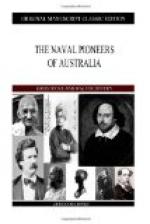Gregory Blaxland, William Lawson, and William Charles Wentworth, in Governor Macquarie’s time, were the first men to make an appreciable advance to the west, inland from the sea. Lawson was a lieutenant in the New South Wales Corps, in the Veteran Company of which notorious regiment he remained attached to the 73rd when the “Botany Bay Rangers” went home. Blaxland was an early settler in the colony, and Wentworth was the son of a wealthy Norfolk Island official, who had sent his boy home to be educated, and when these three men went exploring, young Wentworth had just returned to Australia. In 1813, after many hard trials, by keeping to the crown of the range and avoiding the impenetrable gorges which their predecessors had thought would lead to a pass through the barrier, they managed to gain the summit of the main range, and then returned to Sydney. The work had taken a month to perform, and Macquarie promptly sent out a fully equipped party to follow up the discovery. So thoroughly did the governor back up the work of the explorers that by January, 1815, the convict-made road had been completed to Bathurst, and the Blue Mountain ranges were no longer a barrier to the good country of the west.
The Humes, Evans, Oxley, and the rest of the land explorers followed as the years went on, and very soon there was not a mile of undiscovered land in the mother-colony. Attempts to penetrate the interior of the great continent followed, and that work and the opening of the far north, with its too often accompaniments of disaster and death, went on until quite recent times. Occasionally even now we hear much talk of expeditions into the interior, but newspaper-readers who read of such exploring parties can generally take it for granted that stories of hazard and hardship nowadays lose nothing in the telling, especially where mining interests and financial speculation are concerned.
By way of ending to this story of the naval pioneers of Australia, it will perhaps be not amiss to show what the navy was in Australia at the beginning of the century and what it is now at its close. A return issued by Governor King on the 4th of August, 1804, showed that the Buffalo, ship of war, with a crew of 84 men, the Lady Nelson, a 60-ton brig, with 15 men, were the only men-of-war that could be so described on the station. The Investigator, Flinders’ ship, was then being patched up to go home, and she is stated to have 26 men rated on her books. Belonging to the Colonial Government were the Francis, a 40-ton schooner, the Cumberland, 20-ton schooner, the Integrity, a cutter of 59 tons, the Resource, a schooner of 26 tons, built from the wrecks of the Porpoise and Cato, and some punts and open boats. The crews of all these vessels amounted to 145 men.
A return dated six months later shows that there were 23 merchant vessels owned, or constantly employed, in the colony, of a total tonnage of 660 tons, carrying crews numbering altogether 117. The vessels varied in size from the King George, of 185 tons and 25 men, to the Margaret, of 7 tons and 2 men.




